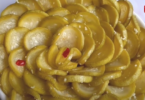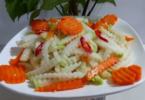Vietnamese Pickled Young Jackfruit – A Chewy, Tangy Pickle with Traditional Roots
Vietnamese pickled young jackfruit, or Mit Non Muoi Chua, is a traditional dish made from thin slices of green jackfruit, soaked in a simple brine until they become tangy, chewy, and refreshing. Common in rural kitchens across Vietnam, this dish is light, healthy, and surprisingly easy to make. In this article, VNIFood will show you the full process, list of ingredients, and creative ways to enjoy this classic part of Vietnamese cuisine.
What Is Mit Non Muoi Chua?

Mit Non Muoi Chua, or Vietnamese pickled young jackfruit, is a traditional dish made by fermenting slices of unripe (green) jackfruit in a lightly salted brine. It’s popular in many rural areas of Vietnam, where families often grow jackfruit trees and make use of the young fruit before it ripens. Once pickled, the jackfruit takes on a slightly sour, chewy, and mildly salty flavor, with a texture similar to bamboo shoots or young banana blossoms. This dish is typically served as a condiment alongside rice, braised meat, tofu, or as part of a refreshing salad. It’s simple to make, naturally fermented, and loved for both its taste and health benefits—especially its fiber and probiotic content.
Ingredients You’ll Need

- 300g young green jackfruit
- 1 tablespoon salt
- 1 teaspoon sugar
- 400ml filtered water
- 2 cloves garlic, sliced
- 1 small red chili, sliced
- 1 clean 500ml glass jar with lid
The Pickling Process
Step 1: Prepare the Jackfruit

- Peel and clean the jackfruit:
- Use gloves or oil your hands to avoid sticky sap.
- Peel off the green outer skin and remove the core.
- Cut the young jackfruit into thin strips or small bite-sized slices (about 5–7 cm long).
- Soak in salt water:
- Place the sliced jackfruit into a bowl of water with 1 teaspoon of salt.
- Let it soak for 15–20 minutes to remove any sap and bitterness.
- Rinse well and drain completely using a clean towel or colander.
Step 2: Prepare the Brine

- In a small pot or bowl, combine:
- 400ml filtered water (or rice rinse water for natural fermentation)
- 1 tablespoon salt
- 1 teaspoon sugar (optional)
- Stir well until the salt and sugar dissolve completely.
- Let the brine cool to room temperature before pouring it into the jar.
Step 3: Pickle and Ferment

- Layer the jackfruit:
- Place the prepared jackfruit slices into a clean, dry glass jar.
- Add sliced garlic and chili if you’d like more aroma and heat.
- Pour in the brine:
- Make sure the jackfruit is fully submerged in the liquid.
- If needed, place a clean leaf (like banana leaf or mustard leaf) on top to keep the jackfruit under the surface.
- Seal the jar:
- Tightly close the lid.
- Let the jar sit at room temperature (22–28°C) for 2–3 days to ferment.
- Store in the fridge:
- After the pickles become lightly sour and aromatic, move the jar to the refrigerator to slow down fermentation.
- Enjoy within 5–7 days for best taste and texture.
Tips from My Mother – Make Your Pickled Jackfruit Just Like Homemade
1. Always oil your hands when handling raw jackfruit
Young jackfruit releases sticky sap when peeled and cut. My mom always rubs a bit of cooking oil on her hands and knife to prevent sticking. It keeps everything cleaner and safer for slicing.
2. Soak the slices twice to remove bitterness and sap
After slicing, she soaks the jackfruit once in salty water to draw out the sap, and then rinses it with clean water before soaking again in slightly warm water. This double-soak method removes any bitterness and gives the final pickle a cleaner, more delicate flavor.
3. Blanch quickly to lock in the color and crunch
She blanches the jackfruit in boiling water for 1–2 minutes and then transfers it to cold water immediately. This keeps the jackfruit bright white, prevents it from becoming slimy, and gives it that perfect chewy-yet-crisp bite.
4. Add a few slices of ginger or lemongrass for aroma
Sometimes, just garlic and chili aren’t enough. My mom adds a few slivers of fresh ginger or crushed lemongrass stalks into the jar. It lifts the flavor and gives the pickles a naturally pleasant fragrance.
5. Use boiled rice water for natural fermentation
Instead of plain water, she often uses cooled rice rinse water (nuoc vo gao) for the brine. This helps natural fermentation develop more complex flavors — slightly fruity, pleasantly sour, and more “homey.”
6. Let the jackfruit “breathe” before sealing the jar
My mother always leaves the lid slightly loose during the first 12–24 hours of fermentation. “Let the jackfruit breathe before you lock in the flavor,” she says. This allows natural gases to escape and prevents pressure buildup, especially on hot days. After that, she seals the jar tightly and lets the rest of the magic happen in peace.

Conclusion
Vietnamese pickled young jackfruit (Mit Non Muoi Chua) is a wonderful example of how simple ingredients and traditional methods can create a dish that’s both healthy and delicious. Its chewy texture, mild sourness, and plant-based nature make it a great condiment for both meat lovers and vegetarians. Whether enjoyed with rice, tossed into a salad, or served cold on a hot day, this humble pickle brings freshness and balance to every meal.
Ready to bring a piece of Vietnam into your kitchen? Start pickling your own mit non muoi chua today with just a few simple steps! Show us your version by tagging #VNIFood on social media. Discover more easy-to-make Vietnamese food and traditional condiments on our website!
- Step 1: Prepare the Jackfruit Peel and clean the jackfruit: Use gloves or oil your hands to avoid sticky sap. Peel off the green outer skin and remove the core. Cut the young jackfruit into thin strips or small bite-sized slices (about 5–7 cm long). Soak in salt water: Place the sliced jackfruit into a bowl of water with 1 teaspoon of salt. Let it soak for 15–20 minutes to remove any sap and bitterness. Rinse well and drain completely using a clean towel or colander. Optional – Blanching for better texture: Bring a pot of water to a boil. Blanch the jackfruit slices for 1–2 minutes. Remove and rinse under cold water. Let them cool and dry fully before pickling.

- Prepare the Brine In a small pot or bowl, combine: 400ml filtered water (or rice rinse water for natural fermentation) 1 tablespoon salt 1 teaspoon sugar (optional) Stir well until the salt and sugar dissolve completely. Let the brine cool to room temperature before pouring it into the jar.

- Step 3: Pickle and Ferment Layer the jackfruit: Place the prepared jackfruit slices into a clean, dry glass jar. Add sliced garlic and chili if you’d like more aroma and heat. Pour in the brine: Make sure the jackfruit is fully submerged in the liquid. If needed, place a clean leaf (like banana leaf or mustard leaf) on top to keep the jackfruit under the surface. Seal the jar: Tightly close the lid. Let the jar sit at room temperature (22–28°C) for 2–3 days to ferment. Store in the fridge: After the pickles become lightly sour and aromatic, move the jar to the refrigerator to slow down fermentation. Enjoy within 5–7 days for best taste and texture.









